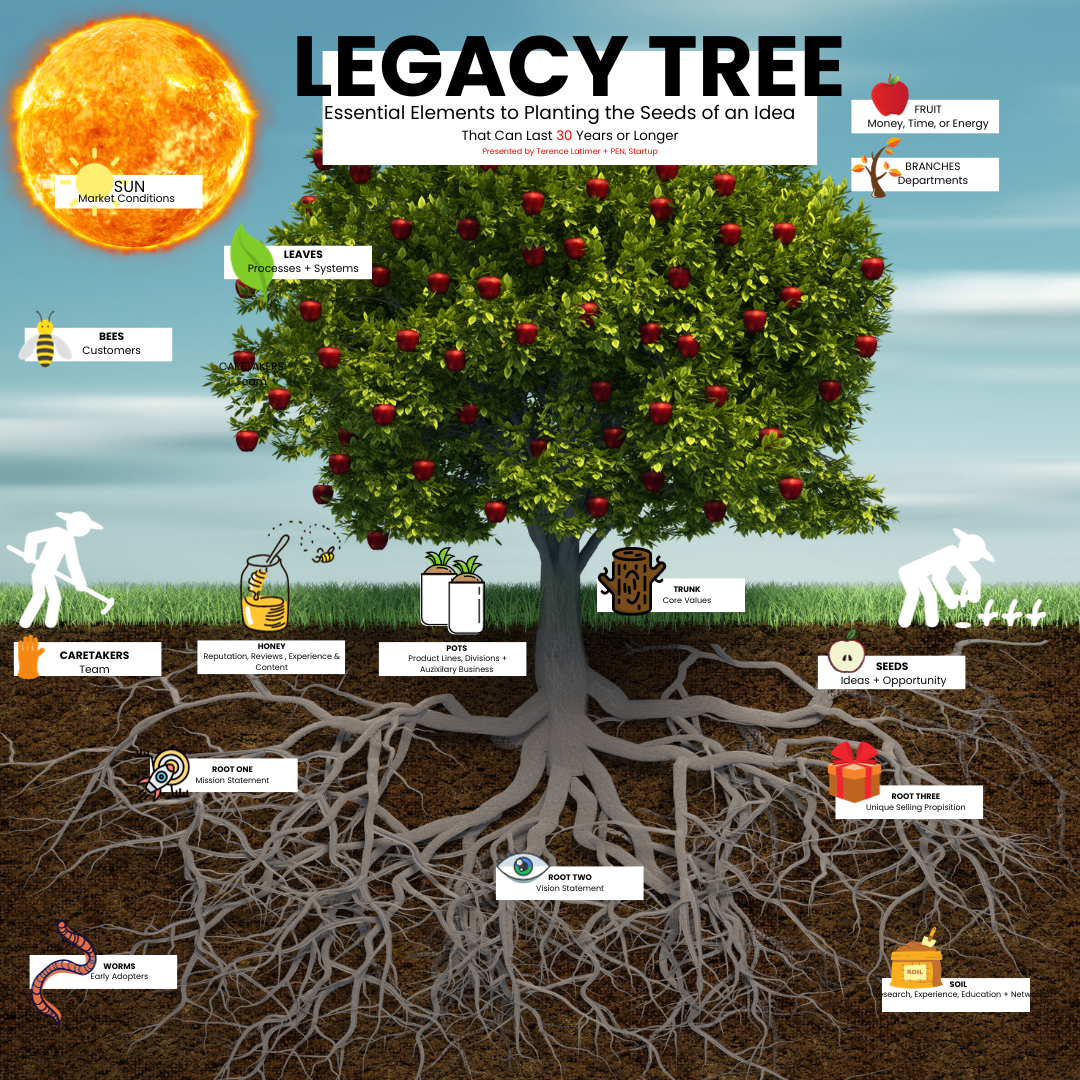Developing Your Brand Story
Great stories have a personality. Your brand, and organization, have a great story that needs to be told. Great stories have great endings, and exhibit the timeless qualities which connect and unite people through shared feelings, emotions, and most importantly, a shared vision. When considering your story, it also becomes important to think about the characters, particularly the heroes and villains.
By developing your brand story, not only will you uncover yourself as its hero, you'll tap into deeper elements found in your business plan. Your business plan is a functional document that tells the story of your business, in narrative form, of its operational strategy and functions. All great stories include qualitative and quantitative information to help support said story's content and context.
Content and context combine to communicate fact and a bit of aspirations, helping prospective customers and future teammates match the movie in their heads, with the movie in yours.
When considering your brand story, its important to allow you and your organizations personality, to shine.
A winning personality matched with a great story helps potential clients understand how and why they might want be able to build relationships with you.
Defining Your "Love Language" By Contributing To Online Conversations
Your brands love language, or the keywords, phrases, topics, and hashtags, helping your customers discover you, also uncovers the topics you enjoy discussing both online and offline.
Learning how to have conversations with your customers online is one of the most important activities you can invest in when considering the process of customer relationship management, or the process of making a relationship connection with a customer.
Standardizing your "Love Language" helps you understand the pain points and problems your customers are experiencing. Creating content, in the form of social media posts, blogs and videos, then helps to answer and solve for their most burning questions or desires, on their journey to discovering the value of your products and services.
Your love language and personality shows up in small quirks like word choices or phrases. When you and your team are tapped into the essence of your brand, it becomes easier to unfirmly communicate the point of view your organization.
Great stories are for everyone even when only written for one person. If you attempt to write with a wide, general audience in mind, your story will sound fake and might lack emotion. No one will be interested. Write for one person. If it’s genuine for the one, it’s genuine for the rest.
Defining Your Brand Guidelines
Your Brand Guidelines is a formalized document used to communicate you, or your brands personality online. Both individuals and organizations should consider their brands personality or avatar to define the topics and conversations customers should expect to have when engaging with them. Brand guidelines also helps customers to define your "brand affinity."
Your Brand Guidelines is valuable for a variety of reasons:
- Maintaining communications consistency
- Outlining design rules
- Createing marketing content
- Ensuring brand identity
- Enhancing recognition
Insightful Analysis Enhances Business Strategy
Qualitative Stories Found In Your Business Plan
Mission + Vision Statement
Inspiring vision, guiding mission, your purpose shapes the better future your product or solution provides.
Core Values
Fundamental beliefs that guide actions, decisions, and organizational culture.
Unique Selling Proposition
What sets your product/service apart from the competition.
Key Numbers Drive Business Performance
Quantitative Data Communicated in Your Business Plan
Accounts Receivables & Payable
Money owed to a business by its customers and money a busines owes to suppliers and creditors for goods + services.
Sales Strategy
Your organizations strategy for achieving its revenue and sales targets, representing market share.
Financial Reporting
Income statements, Forecasting, Profit & Loss, and important financial reports
Applications of Your Brand Identity and Guidelines
Utilizing Your Brands Personality to Achieve Business Results
As you understand the language and conversations spoken about your brand, you begin to understand how the summary of said conversations helps to determine your brands reputation and what customers and potential partners can come to expect from you.
Customers generally like to work with the people and brands they like, trust and know. Showing up for your customers consistently, while also completing repeatable tasks with the same quality of service, implies customers can expect to have conversations with you for a long time to come.
Consistency helps breed new customers in the co-creation of the language and phrases communicating changing and maturing feelings and emotion. Your brands feedback loop aggregates the stories customers and partners communicate your brand, into a collection of stories highlighting positive, negative or neutral stories regarding your band and its ability to deliver on time and as expected.
These stories and datapoints should be communicated within the organization to develop pride, or to inform changes in your organizational strategy to better align with customer demands.
Visual Identity
Logo Usage
Color Palette
Typography
Imagery and Photography
Graphic Elements
Brand Messaging
Brand Voice and Tone
Taglines and Slogans
Brand Story
Key Messages
Content Guidelines
Brand Application
Stationary (letterheads, business cards)
Marketing Collateral (brochures, flyers)
Website Design and Usage
Social Media Guidelines
Advertising and Promotion
Steve Jobs Introduces the Macintosh
Steve Jobs is considered to be one of the greatest Brand Evangelists of our generation.
Jobs' brand advocacy and personification of Apple's strict design standards is part or the brands organizational success and reputation for offering quality products and services.
Contagious: Why Things Catch On
According to Jonah Berger, the key to making things really popular happens long before it's discussed at the water cooler or "liked" online. It starts with the message.
Drawing on his groundbreaking research, he explains that there are six key steps that make products or ideas contagious. Those "STEPPS" -- Social Currency, Triggers, Emotion, Public, Practical Value, and Stories -- will help any product or idea spread like wildfire.
30 Years in 3-Minutes Workshop
Building a 30-year brand or legacy business is similar to planting the seed of a tree. Plant an oak today to nurture the environment and requirements for what it takes to develop a long term business that lasts.
Join Jala Eaton of On My Own Financial and I as we discuss concepts related to Jala's reasons for wanting to become your Wealth Bestfriend®!
As you consider the brilliance and effort it will require from you to succeed in scaling your brand, I'd like for you include:
- The diligence of protecting your ideas and Intellectual Property
- Your personal purpose and why your brand and work matters
- Estimating the energy and effort necessary to birth your ideas and allowing them to grow
- Plant the seeds of opportunity for others to share in your idea and vision
- Defining and understanding the complex ecosystem that is the operating environment, or the ecosystem, that your business is operating in
Considering the tools of the trade, the focus comes in the form of providing the conditions for longevity to take shape; a healthy foundation is grounded in reality.
Using the visual below, a strong connection reality comes in the form of defining your organizations:
- Roots: In the Form of Mission Statement, Vision Statement and Unique Selling Proposition
- Trunk: In for the Form of Core Values
- Leaves: Defined by Changing Processes and Systems
The "soil" are the conditions which allow for your ideas and legacy to take shape: in my humble opinion, the seeds of an idea are both special and ordinary; what matters is the application of interactivity, engagement and translating your business plan and brand into an actionable plan.
Your business legacy then, and your ideas, comes in the form of maintaining the circumstances allowing for the healthy and successful development of an organism that sprouts life and provides for others. The beauty of the concept maximizes your limited time to provide shade and fruit for generations to enjoy.

Determining Key Business Plan Terms
Properly Communicate Your Business Plan to Internal and External Customers and Teammates
Contextualizing Content Related to Marketing, Sales, and the Products You Offer
As organizations focus on enterprise wide digital transformation strategies, internal departments align around suites of digital tools and products allowing for the deliver of business value. Business Value communicates strategic objectives, key results, and reinforces reputation by matching results and expectations, which should clearly be communicated through your business plan.
By determining your organizations ability to follow through on its commitment, Brand Affinity helps to associate and reinforce the keywords, phrases, and topics, or the key terms, most important to your organization.
Topics of conversation help customers discover your expertise, while allowing them to uncover how your solution, your experience, and your team, are acapable of solging the problems they perhaps don't have the language to convey.
Key terms found in your business plan are related to:
- Who Your Team Is and Their Backgrounds and Subject Matter Expertise
- What Differentiates You and Your Team from Competitors
- The Products and Services You Offer
- How You Market Your Products
- Ways To Purchase Your Products and Services
By identifying these key terms and reinforcing them by using them often, you provide a simplified path for your customers journey through simple and effective communication.
Remember, your business plan isn't a static document: it's a dynamic tool driving various aspects of your business which must be updated from time to time.
Determining Your Tools and Rules
Marketing efforts leverage the plan's insights to create compelling campaigns that align with the company's core objectives. Sales teams use it as a blueprint, tailoring their pitches to resonate with potential clients and investors.
Furthermore, the business plan informs product development, ensuring that offerings meet market needs. This evolution exemplifies the interconnected nature of business functions, where a well-crafted plan not only guides but also actively shapes a company's trajectory.
By selecting the right "tools and rules," or agreeing to the technologies teammates have access to in the delivery of business value, you provide your team structure and guidance, as well as flexibility, regarding the policies, procedures, and planning, necessary to achieve the organizations long term mission and vision, according to its core values.
The beauty of this process comes in the form of exciting possibilities regarding the growth of both teammates and customers as a result of experience the value your business is able to offer.
Sales Strategy
A short description of this great feature.
Topics, Keywords and Hashtags
A short description of this great feature.
Content Strategy
A short description of this great feature.
Sales Materials and Product Descriptions
A short description of this great feature.
Creatively Creating Killer Copy
(Contextualized Copy x Great Content) + (Efficient Communications x Effective Language) = A Winning Brand Strategy
In the dynamic landscape of brand strategy, success comes down to who is most successfully able to convince customers to choose their solution over others. In an age where the average consumer is responsible for 1000's of brand messages per day, smart marketers and brand strategists have identified storytelling as a useful tool.
In my opinion, stories are less threatening than the average commercial or print ad. The popular pop-up's found on websites in the early 2000's are examples of inefficient marketing, pushing a message onto users without first contextualizing why the content, copy or message, matters.
The sophistication of marketing in 2023 comes in the form of allowing both qualitative and quantitative data, tell the story. Content like business reviews and customer feedback are just some of the ways we begin to understand the story others are telling about your business. Strategic brand leaders, managers and ambassadors understand that the real power comes in the form of participating in the conversation by thoughtfully communicating the stories most important to your business.
These might come in the form of:
- How and Why You Got Into Business
- An Example of A time You Successfully Helped a Customer or Teammate
- A Challenge Your Currently Experiencing
- A Point of View Regarding Industry Trends or Highlights and Your Perspective
Effective stories pull users into the setting, versus forcing it on them. Effective storytelling in marketing is an ever improving process, yet can be boiled down to strategic milestones:
- Introducing a Story
- Identifying the Characters
- Laying the Setting
- Explaining the Conflict
- Identifying the Perils
- Providing the Map
(Contextualized Copy x Great Content) + (Efficient Communications x Effective Language) = A Winning Brand Strategy
Here's the breakdown:
Contextualized Copy: Tailored content that resonates with the target audience, offering relevance and value.
Great Content: Compelling, high-quality material that engages, informs, and captivates consumers.
Efficient Communications: Streamlined, effective dissemination of the brand message across various channels, ensuring it reaches the right ears.
Effective Language: The power of words harnessed to convey the brand's uniqueness and value proposition.
When these elements converge, they create a brand strategy that draws attention and also creates deep connections with your customers. Your brand strategy is about crafting a narrative that fits the context, backed by stellar content, efficiently communicated through the right channels, and delivered in language that resonates. The result?
A brand that stands out, engages its audience, and succeeds in a competitive marketplace.
[Recommended Video] GaryVee | How To Do Social Media Marketing The Right Way In 2023
This episode is a fireside chat Gary had with SK-II in Singapore. He shares valuable insights on building a successful business, effective marketing strategies, staying relevant in today's competitive market, making tough decisions, evolving your brand, and how to do social media marketing the right way in 2023.
Planting the Seeds of a 30-Year Legacy Business
This training explores concepts around brand development and your business plan. A video complimenting that 30-Years in 3-Minutes Training, we walk through concepts from the training through the lens of Women’s History Month.
This training is focused on:
- Market Research
- Choosing a Brand Name
- Purchasing a Website Domain
- Choosing a Social Media Platform + Creating Content
Start Planning Your Content
Getting Started Planning Your Content By Breaking Down Your Brands Past, Present and Future
Once you identify the Love Language associated with your business plan, you're ready to combine your marketing, product, sales, and technologies, in order to help amplify your brand and to create a strategy, built around content, where you can begin the process of having direct 1-to-1 conversations with your customers, on the platforms they enjoy participating in.
Contribute to the conversation while achieving strategic objectives through the Art of Social Media Conversations. By learning the in's and outs of your brand, as well as the in's and out's of your customers.
Focus on the online communities your customers are participating in; you can do this by creating authentic conversations through inspiring and thought provoking artifacts, e.g. the videos, blogs, and content designed to get your customers questions answered.
With time, your audience will begin to raise its hands, removing the guesswork of who's interested in your products. Popular data and analytics tools offered by your favorite social media platform or digital tools will help you better understand consumer behavior, and the content, topics, products and services which most contribute to the creation of business value. Once you begin to connect your data to the customers data, exciting possibilities occur as you begin to visualize and understand the impact your product, brand and team have had in the form of improving lives.
Helping lives, is a metric that Product Owners love. Improving lives offers the ability to explain a broad organizational goal which can help to contextualize associated business goals. Tracking metrics associated with your business growth and aligning them with your content strategy can help with this process.
The goal is to achieve broad buy in on Objectives, and the Key Results of achieving those objectives, while charting the path to your organizations long and short term future.
Communication Business Metrics Associated with Growth
Pirate Metrics, in the form of AARRR helps to ensure you're never swimming in circles. Scoring and tracking the achievement of thse metrics, helps to communicate how close or far away the organization is from achieving its long term business goals.
Tracking the data associated with your content helps to provide a north star and opportunity to pivot underperforming and/or underperforming content to provide you a baseline of its efficiency to drive strategic goals.
Spray and play, or creating content and hoping it lands you customers, might be a strategy, but one I don't subscribe to or recommend. My thought process and recommendation is to create relative content that meets your business goals based on measurable performance and the thoughtful art of applying strategy to your marketing and your content initiatives.
The User Experience, closely aligned with the Customer Journey, helps to ensure you have the content and strategy to help nurture customers from the initiation of their problem to finalizing a solution through your products.
AARRR Pirate Metrics framework is an acronym for a set of five user-behavior metrics that product-led growth businesses should be tracking: acquisition, activation, retention, referral, and revenue.
- Acquisition (or awareness) – How are people discovering our product or company?
- Activation – Are these people taking the actions we want them to?
- Retention – Are our activated users continuing to engage with the product?
- Referral – Do users like the product enough to tell others about it?
- Revenue – Are our personas willing to pay for this product?)
The 30 Years in 3 Minutes Workbook
If you're a big dreamer or entrepreneur interested in communicating the long term vision of your organization, the 30 Years in 3 Minutes Workbook is designed to help you do just that.
Remember, having the courage to change the world begins with taking down time to communicate what things will look like should you be successful:
If you start with the customer, you'll reverse engineer the map and path helping them arrive to the promised land.


Develop Your Origin Story
A brand's origin story is its narrative of how it started, reflecting values, building trust, and connecting emotionally with customers. It's important for authenticity and brand identity.

Define Your Love Language
How a brand expresses care and connection to customers. It's important for building loyalty, trust, and fostering strong relationships.

Organize Your Business
Structuring operations, roles, and resources for efficiency and effectiveness, ensuring it functions cohesively to achieve its goals and mission.






